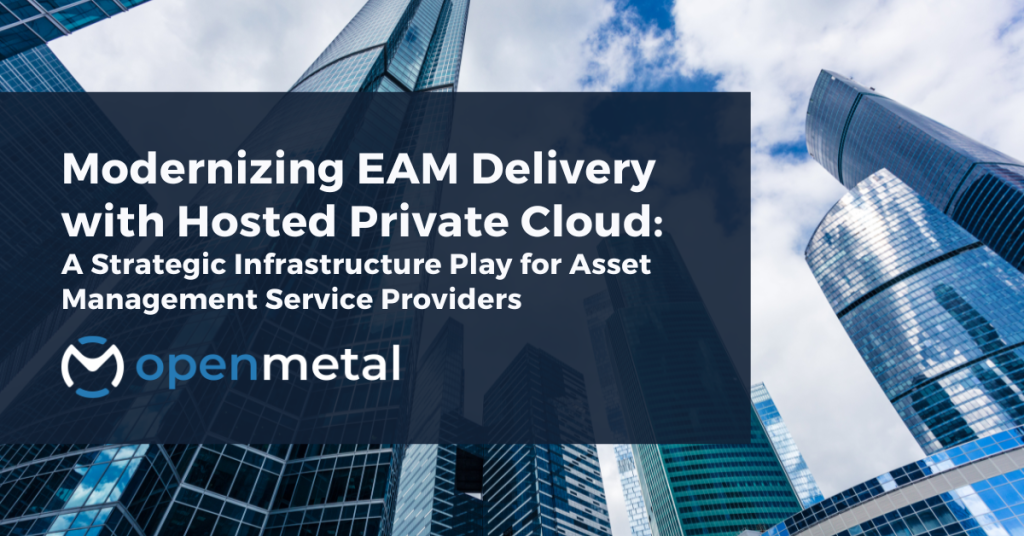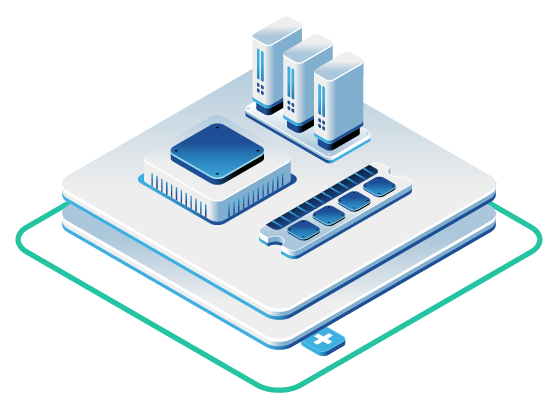
Are you looking to modernize your cloud infrastructure?
The OpenMetal team is standing by to assist you with scoping out a custom infrastructure plan to fit your needs, budgets and timelines.
Executive Summary
Enterprise Asset Management (EAM) consulting firms face an infrastructure paradox. Your clients demand the scalability and agility of cloud computing, yet they require the control, security, and predictable costs traditionally associated with on-premises deployments. Meanwhile, hyperscaler platforms create cost volatility and compliance headaches, while traditional colocation lacks the flexibility modern EAM implementations require.
The solution may very well lie in hosted private cloud infrastructure. By leveraging dedicated, single-tenant environments built on open-source technologies like OpenStack and Ceph, EAM service providers can deliver client environments that combine cloud agility with dedicated server control—all while improving profit margins and reducing deployment timelines.
The Infrastructure Challenge in EAM Delivery
As an EAM consultant or system integrator, you manage complex deployments for public utilities, transportation authorities, energy companies, and other critical infrastructure clients. These organizations rely on platforms like IBM Maximo, Infor EAM, and similar systems to manage assets worth billions of dollars. For organizations in the mobility and logistics sector, leveraging transportation software development services can help enhance operational visibility, asset tracking, and system integration within EAM environments.
Your clients expect more than software implementation—they demand infrastructure that delivers consistent performance, maintains strict data governance, and provides predictable costs over multi-year contracts. Yet traditional infrastructure approaches fall short of these requirements.
Consider the typical challenges you face:
- Performance bottlenecks when EAM platforms compete for resources on shared infrastructure
- Compliance complexity when clients require data sovereignty or regulatory adherence
- Cost unpredictability as hyperscaler bills fluctuate based on usage patterns you can’t control
- Integration difficulties when connecting EAM systems to existing ERP, SCADA, GIS, and IoT environments
- Client isolation concerns when multiple organizations share the same underlying infrastructure
These challenges directly impact your ability to deliver successful projects, maintain healthy margins, and build long-term client relationships.
Why Infrastructure Matters in EAM Deployments
Modern EAM implementations are far more complex than traditional enterprise software deployments. Understanding these unique requirements helps explain why infrastructure choice becomes a strategic decision rather than a technical detail.
Performance-Sensitive Workloads
EAM platforms handle real-time work order processing, mobile application synchronization, GIS integrations with platforms like Esri, and increasingly sophisticated analytics workloads. These applications require consistent, high-IOPS storage and predictable compute performance.
When your Maximo deployment shares resources with hundreds of other tenants on a hyperscaler platform, performance becomes unpredictable. A spike in another tenant’s workload can cause your client’s mobile workers to experience delays accessing critical asset data in the field.
Integration Complexity
EAM platforms rarely operate in isolation. They integrate with ERP systems for financial data, SCADA systems for operational control, IoT sensors for condition monitoring, and business intelligence tools for analytics. Each integration point requires network connectivity, often with specific latency and bandwidth requirements.
Hyperscaler platforms offer limited control over network topology and routing. You can’t optimize traffic flows between integrated systems or implement the custom firewall rules many clients require for security compliance.
Security and Compliance Requirements
Your clients in regulated industries—utilities, transportation, energy—operate under strict compliance frameworks. They need infrastructure that provides:
- Data sovereignty with guaranteed geographic boundaries
- Root-level access for security configuration and monitoring
- Audit trails that meet regulatory requirements
- Single-tenant isolation to prevent cross-contamination risks
Hyperscaler “virtual private clouds” offer isolation at the network level but still share underlying physical infrastructure. For clients with strict compliance requirements, this shared tenancy model creates unacceptable risk.
Long Lifecycle Contracts
EAM engagements typically span 5-15 years, with predictable monthly or annual costs built into client contracts. Hyperscaler pricing models—with their variable egress charges, storage tier complexity, and frequent rate changes—make it difficult to offer clients the cost predictability they require.
When your infrastructure costs fluctuate month to month, either you absorb the variance (hurting margins) or pass it through to clients (damaging relationships).
Comparing Infrastructure Approaches for EAM Delivery
Let’s examine how different infrastructure models address the core requirements of EAM service delivery:
Hyperscaler (AWS/Azure)
Hyperscalers offer rapid deployment and highly flexible scaling, making them ideal for fast-growing or unpredictable workloads. However, this comes with trade-offs. Data sovereignty is limited due to restricted control over geographic placement. Performance consistency can vary because resources are shared across tenants, and client isolation is typically virtual rather than physical. Cost predictability is a challenge, as pricing is based on fluctuating usage, which can lead to unexpected bills. While integration is fast for standard configurations, deeper network control and compliance customization are constrained due to the shared responsibility model.
Traditional Colocation
Traditional colocation provides full control over hardware, offering strong performance consistency and physical isolation. It’s well-suited for organizations that need to tightly control compliance and data sovereignty, albeit usually tied to a single location. Costs are more predictable in terms of operational expenses, but require significant upfront capital investment. Deployment times can be long—often taking weeks or months—and scaling is limited by the physical space available in the data center. Integration and compliance control are fully in the customer’s hands, but this also means higher complexity and overhead.
Hosted Private Cloud
Hosted private cloud combines many of the strengths of both hyperscalers and colocation. It offers dedicated hardware for performance consistency and true single-tenant isolation, ensuring strong security and compliance postures. Unlike traditional colocation, it allows for rapid deployment (within minutes to hours) and flexible scaling within the dedicated environment. Costs are fixed and predictable with monthly OpEx pricing. Organizations have full control over data sovereignty, often across multiple regions, and gain simplified integration and infrastructure management—removing much of the complexity typically associated with traditional setups.
| Requirement | Hyperscaler (AWS/Azure) | Traditional Colocation | Hosted Private Cloud |
| Data Sovereignty | Limited geographic control | Full control, but single location | Full control across multiple regions |
| Performance Consistency | Shared resources, variable performance | Dedicated hardware, consistent | Dedicated hardware with cloud flexibility |
| Client Isolation | Virtual isolation only | Physical isolation per rack/cage | True single-tenant private clouds |
| Cost Predictability | Variable usage-based pricing | High CapEx, predictable OpEx | Fixed monthly OpEx pricing |
| Deployment Speed | Fast for standard configs | Slow (weeks to months) | Fast (minutes to hours) |
| Scaling Flexibility | Highly flexible | Limited by physical space | Flexible within dedicated environment |
| Compliance Control | Limited, shared responsibility | Full control, high overhead | Full control, managed infrastructure |
| Integration Control | Limited network control | Full control, complex setup | Full control, simplified management |
Table: Core requirements of EAM service delivery addressed by different infrastructure models
Each infrastructure model serves different needs, but hosted private cloud stands out as a balanced solution. It merges the speed and scalability of hyperscalers with the control, performance, and security of traditional colocation. For organizations seeking predictable costs, strong compliance, and rapid deployment—without sacrificing control—hosted private cloud offers a compelling middle ground.
The OpenMetal Solution: Private Cloud Cores for EAM Excellence
OpenMetal’s hosted private cloud platform addresses the infrastructure challenges facing EAM service providers through a fundamentally different approach: true single-tenant private clouds built on proven open-source technologies.
Instant Deployment with Day 2 Operational Readiness
Unlike traditional infrastructure procurement that takes weeks or months, OpenMetal’s Private Cloud Core deploys in under a minute. Each core consists of three hyper-converged servers running OpenStack and Ceph, providing a complete cloud infrastructure stack that’s immediately operational.
This instant deployment capability transforms how you approach client onboarding. Instead of lengthy infrastructure setup phases, you can provision dedicated environments as soon as client contracts are signed. The infrastructure is Day 2 operational-ready, meaning you can immediately begin deploying EAM applications without additional configuration overhead.
As client requirements grow, each Private Cloud Core supports expansion to hundreds of servers, thousands of virtual machines, and petabytes of Ceph storage—all managed through familiar OpenStack APIs and interfaces.
Fixed, Transparent Pricing for Predictable Margins
OpenMetal offers fixed-price, OpEx-style billing with no surprise egress charges, bandwidth caps, or usage-based overage pricing. This pricing model aligns perfectly with the long-term contracts typical in EAM consulting.
For organizations spending more than $20,000 monthly on public cloud infrastructure, OpenMetal typically delivers cost savings of 35-60% compared to hyperscaler alternatives. These savings come from eliminating the markup and complexity inherent in multi-tenant platforms.
Todd Robinson, President of OpenMetal, explains the business impact:“EAM consultants need infrastructure they can mark up and resell confidently. Our fixed pricing model lets service providers build healthy margins into their contracts while offering clients the cost predictability they demand for long-term engagements.”
True Single-Tenant Architecture
Each OpenMetal deployment creates a genuine private cloud—not a virtual private network masquerading as dedicated infrastructure. Your clients receive fully isolated OpenStack environments with no shared underlying resources.
This architecture provides root-level SSH and IPMI access to tune servers, configure security policies, and optimize infrastructure for specific EAM workloads. You maintain complete control over the technology stack, from the hypervisor level up through application deployment.
OpenStack and Ceph: Enterprise-Grade Open Source Foundation
OpenMetal’s platform builds on mature OpenStack components including Compute (Nova), Block Storage (Cinder), Networking (Neutron), and Object Storage (Swift). This proven architecture powers critical infrastructure for telecommunications, financial services, and research organizations worldwide.
Cloud storage relies on Ceph, which provides unified object, block, and file services with self-healing capabilities, erasure coding for data protection, and compression for efficiency. Ceph scales from terabytes to exabytes on commodity hardware while maintaining high availability through automatic data replication.
High-Availability and Resiliency for Mission-Critical EAM
EAM platforms support operations that can’t tolerate downtime. OpenMetal’s Ceph-based block storage includes triplicate data copies by default, ensuring data protection even during hardware failures. Live VM migration capabilities maintain application uptime when servers or storage devices require maintenance.
The platform supports multiple failover strategies and operates from Tier III data centers across multiple regions, enabling disaster recovery planning that meets the availability requirements of critical infrastructure clients.
Performance Tuning for EAM Workloads
OpenMetal’s hardware includes enterprise-grade NVMe drives (such as Micron 7450 MAX) and 100 Gbps networking to support the high IOPS requirements of modern EAM platforms. This performance focus matters when EAM mobile applications need immediate access to work orders, or when integration workflows process large volumes of sensor data from IoT devices monitoring critical assets.
Business Impact for EAM Service Providers
Migrating from hyperscaler or colocation infrastructure to hosted private cloud creates measurable business benefits across multiple dimensions.
Improved Profit Margins
Fixed infrastructure costs enable markup-based pricing models that generate predictable revenue streams. Instead of passing through variable cloud costs (which often surprise both you and your clients), you can build healthy margins into service contracts while still offering competitive total costs.
Faster Client Onboarding
Pre-configured, Day 2-ready Private Cloud Cores eliminate the infrastructure setup bottleneck that often delays EAM project launches. You can provision dedicated client environments immediately upon contract signing, accelerating time-to-revenue and improving client satisfaction.
Enhanced Compliance and Client Confidence
Hosting client environments in US-based Tier III facilities with SOC 2 and ISO certifications provides the compliance foundation many EAM clients require. Single-tenant architecture eliminates the security concerns associated with shared infrastructure, while root-level access enables the security configurations clients demand.
Technical Differentiation in Competitive Markets
Full infrastructure control enables service offerings that competitors using hyperscaler platforms cannot match. You can offer hybrid deployments, custom network topologies, and specialized performance optimizations that differentiate your services in competitive EAM markets.
Use Case: Scalable Multi-Client Maximo Architecture
Consider a practical scenario: your consulting firm manages IBM Maximo deployments for dozens of utility and transportation clients. Each client requires isolated environments, but traditional approaches create either cost bloat (separate hyperscaler accounts) or security risks (shared tenancy).
The Challenge
Standing up separate virtual machines per client in public cloud environments creates several problems:
- Cost accumulation as each client environment incurs separate compute, storage, and networking charges
- Security complexity when implementing proper isolation between client workloads
- Management overhead when monitoring and maintaining dozens of separate cloud accounts
- Integration difficulties when clients require VPN connections to existing on-premises systems
The OpenMetal Solution
With OpenMetal’s hosted private cloud, you can provision a dedicated Private Cloud Core for each client, creating truly isolated OpenStack environments that share no underlying resources. Each client receives:
- Dedicated compute and storage with guaranteed performance characteristics
- Private IP address ranges that integrate seamlessly with existing client networks
- Custom firewall and security policies configured to meet specific compliance requirements
- VPN connectivity enabling secure integration with on-premises ERP and SCADA systems
- API-driven automation for consistent deployment and management across all clients
This architecture enables centralized monitoring and logging across all client environments while maintaining the strict isolation requirements of regulated industries.
EAM Development and Testing Without Overhead
EAM projects typically require multiple parallel environments per client: development instances for customization work, test environments for integration validation, and training systems for end-user education. Traditional approaches make these environments expensive and time-consuming to provision.
OpenMetal’s Private Cloud Core architecture transforms development and testing workflows:
On-Demand Environment Provisioning
Development and test environments can be deployed in minutes using pre-configured templates, eliminating the weeks-long procurement cycles associated with traditional infrastructure. When testing completes, environments can be deprovisioned immediately, avoiding ongoing costs for unused resources.
API-Driven CI/CD Integration
OpenStack APIs enable integration with continuous integration and deployment workflows, automatically provisioning test environments when code changes are committed and tearing them down when testing completes. This automation reduces manual overhead while ensuring consistent test conditions.
Secure Remote Access
Development teams can access client-specific environments securely from any location without requiring site-specific hardware or complex VPN configurations. This flexibility supports distributed development teams while maintaining the security isolation clients require.
Why OpenStack and Ceph Architecture Excels for EAM
The technology foundation underlying OpenMetal’s platform matters for EAM deployments. OpenStack and Ceph provide specific advantages that align with EAM requirements:
Proven Enterprise Reliability
OpenStack powers cloud infrastructure for telecommunications companies, financial institutions, and research organizations worldwide. This proven track record provides the reliability foundation that critical infrastructure clients demand.
Unified Storage Services
Ceph provides object, block, and file storage services from a single platform, simplifying storage management while providing the flexibility to support diverse EAM application requirements. Whether you need high-performance block storage for database workloads or object storage for document management, Ceph delivers consistent performance and management.
Vendor Lock-In Avoidance
Open-source architecture eliminates vendor lock-in concerns that many EAM clients raise about hyperscaler platforms. If business requirements change, workloads can migrate to other OpenStack-compatible platforms without application modifications.
Migration Path from Legacy Infrastructure
Many EAM deployments currently run on traditional virtualized infrastructure. OpenStack’s familiar VM-based model provides a natural migration path that doesn’t require application re-architecture, reducing project risk and complexity.
Implementation Recommendations
Successfully migrating EAM service delivery to hosted private cloud requires strategic planning. Consider these implementation approaches:
Start with New Client Engagements
Begin by deploying new client environments on OpenMetal’s platform rather than attempting to migrate existing production systems immediately. This approach reduces risk while building operational experience with the new infrastructure model.
Standardize Environment Templates
Develop standardized OpenStack templates for common EAM deployment patterns. This standardization accelerates client onboarding while ensuring consistent security and performance configurations across all environments.
Leverage Free Trials for Proof of Concept
OpenMetal offers Proof of Concept clouds, enabling risk-free evaluation of the platform’s capabilities. Use these trials to validate performance requirements and develop migration procedures before committing to production deployments.
Plan for Hybrid Integration
Many EAM clients maintain on-premises systems that require integration with cloud-hosted environments. Design network architectures that support secure, high-performance connectivity between OpenMetal private clouds and client data centers.
Taking Action: Your Next Steps
The infrastructure decisions you make today will determine your competitive position in the evolving EAM services market. Organizations that embrace hosted private cloud gain immediate advantages in cost predictability, client satisfaction, and technical differentiation.
Ready to transform your EAM service delivery? OpenMetal’s team of infrastructure specialists understands the unique requirements of asset management applications. We can help you design private cloud architectures that improve margins, accelerate client onboarding, and provide the control your clients demand.
Explore how OpenMetal can help with a PoC Cloud
Start with a risk-free evaluation: Take advantage of OpenMetal’s Proof of Concept program to validate how hosted private cloud can transform your delivery model. Deploy a complete Private Cloud Core environment and experience the difference that true single-tenant infrastructure makes for performance, security, and cost predictability.
Works Cited
- OpenMetal. “Hosted Private Cloud.” OpenMetal.io, https://openmetal.io/products/hosted-private-cloud.
- OpenMetal. “On-Demand Private Cloud.” OpenMetal Resources Blog, https://openmetal.io/resources/blog/on-demand-private-cloud.
- OpenMetal. “Leveraging On-Demand Private Clouds.” OpenMetal Resources Blog, https://openmetal.io/resources/blog/leveraging-on-demand-private-clouds.
- OpenMetal. “Private Cloud vs Virtual Private Cloud.” OpenMetal Resources Blog, https://openmetal.io/resources/blog/private-cloud-vs-virtual-private-cloud/.
- OpenMetal. “Benefits of Private Cloud Hosting for SaaS Providers.” OpenMetal Resources Blog, https://openmetal.io/resources/blog/benefits-private-cloud-hosting-for-saas-providers.
- OpenMetal. “What is Ceph and Ceph Storage?” OpenMetal Documentation, https://openmetal.io/docs/glossary/what-is-ceph-and-ceph-storage/.
- OpenMetal. “Block Storage.” OpenMetal Platform, https://openmetal.io/platform/cloud-cores/block-storage/.
- OpenMetal. “5 Failover Strategies for OpenStack Clouds.” OpenMetal Resources Blog, https://openmetal.io/resources/blog/5-failover-strategies-for-openstack-clouds/.
- OpenMetal. “How to Benchmark Ceph Storage Performance.” OpenMetal Resources Blog, https://openmetal.io/resources/blog/how-to-benchmark-ceph-storage-performance/.
- OpenMetal. “Cloud Success.” OpenMetal Resources Blog, https://openmetal.io/resources/blog/cloud-success/.
- OpenMetal. “Free Trial.” OpenMetal.io, https://openmetal.io/free-trial/.







































